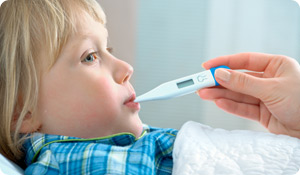
Scratchy throat. Dry cough. Feverish one minute. Cold and shaking the next. Achy head. Achy body. Achy bones. If your child is complaining of these symptoms, she may have the flu.
Influenza, or the flu as it's commonly known, is a virus that infects the respiratory system and makes anyone who catches it feel absolutely miserable. The good news is the flu usually isn't serious and only lasts 3 or 4 days (colds can linger longer). In the meantime, there are plenty of ways to help your child-even a very young one-feel a lot more comfortable until the symptoms subside.
Flu season typically starts in November and runs through April-usually peaking in February. Though the flu is often confused with the common cold, there's quite a difference between the two, says Gordon Schutze, MD, professor of pediatrics at Baylor College of Medicine and a physician at Texas Children's Hospital. "Symptomatically, they are very different. A cold may come on over a number of hours or within a day or two. But there's nothing subtle about the flu," Schutze explains. "Influenza feels like you got hit by a truck. All of a sudden your muscles ache, and a high fever can come out of nowhere."
Treating the Flu
Like the common cold, the flu is caused by a virus, so taking antibiotics won't help.
But there are a number of ways to alleviate your child's discomfort until his body fights off the flu. "I think it's fair to say that parents can easily forget how bad influenza can feel," says the doctor who is also chair of the Committee on Infectious Diseases with the American Academy of Pediatrics. "It takes kids a few days longer than adults to bounce back from the flu."
Here are Schutze's dos and don'ts:
DO
- Use a cool-mist humidifier. "Putting moisture in the bedroom prevents a child's secretions from drying out. Mucus moves easier when it's wet and keeping it that way helps children rid it from their bodies during the flu," Schutze expert explains.
- Rub topical ointments and medicated vapors on your child's chest. Doing so doesn't hurt them and many parents report that it helps sick children relax enough to get the extra rest they need.
- Administer saline nose drops to children too young to blow their noses. The saline breaks up the mucus and helps babies breathe easier.
- Get the annual flu vaccine.
- Get plenty of rest and ingest extra liquids.
DON'T
- Use aspirin. "There is an association between aspirin therapy and the development of Reye's Syndrome in children who have the flu," says Dr. Schutze. (Reye's is a deadly and dangerous disease that affects the brain and liver.) For temporary fever relief, give kids acetaminophen or ibuprofen instead.
- Offer over-the-counter liquid cold remedies. According to Schutze and other experts, data shows they really don't work, especially in children under 5 and aren't particularly effective in other kids, either.
- Give ice baths or use cold compresses on children with high fevers (103 degrees F or more). "The cold on the skin actually makes the body retain heat, " says Schutze. "Tepid water baths and cool rags may help the patient feel a bit better, but neither is necessary."
Reducing the Spread of the Flu
The CDC currently recommends an annual flu shot for children over the age of 6 months. The flu is extremely contagious and responsible for more than 200,000 flu-related hospitalizations per year. Young children under 5 are at increased risk for developing serious flu-related complications, like pneumonia. The vaccine is an effective preventive course of action.
Children with the flu are most contagious beginning one day before symptoms set in and for five to seven days after the sickness reveals itself and all its misery. Many flu epidemics start at school where kids cough and sneeze on desks and each other. Sharing pencils and keyboards also spread germs. At home, the flu spreads when siblings share utensils or handle remote control devices without washing their hands.
You can help reduce the spread of the flu by encouraging good hygiene. Frequent hand washing is essential as well as keeping a child with symptoms home from school or day care. Once she is fever-free for 24 hours, your child can return to her normal routine.
Sources
Interview with Gordon Schutze, MD
Texas Children's Hospital
Nemours Foundation
http://www.kidshealth.org
The Centers of Disease Control and Prevention
http://www.cdc.org





